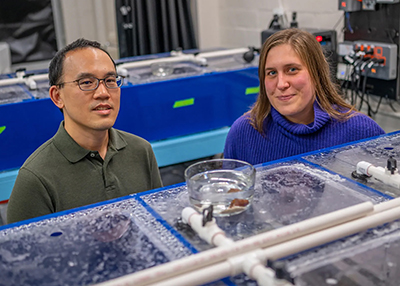Teamwork, in nature and the lab, teaches about climate change
Michigan State University and the University of California, Merced are working to get a better handle on the huge problem of climate change with the help of some very small organisms.
With $12.5 million from the National Science Foundation, MSU and UC Merced are launching an institute to focus on a new angle in climate change. The team will study impacts on microbes and their

symbiotic relationships with host animals, including squid, insects and sea anemones. This information can better inform future climate models as well as immediate and long-term conservation strategies, the team said.
"The vast majority of animal life has evolved with and in close contact with microbial life," said MSU's Elizabeth Heath-Heckman, a co-principal investigator for the project, which is called the Institute for Symbiotic Interactions, Training and Education, or INSITE.
"What we're doing is getting together a lot of different experts to measure short-term and long-term effects of climate change on symbiotic systems," said Heath-Heckman, an assistant professor in the College of Natural Science's Department of Integrative Biology and Department of Microbiology and Molecular Genetics. "Then we can feed that data into models that predict climate change and get more information to the people who manage land and water to protect at-risk species."
Eleven faculty members from four different departments at UC Merced are partners in the study. At MSU, Heath-Heckman is joined by Kevin Liu, an associate professor in the College of Engineering's Department of Computer Science and Engineering. Two consultants are also serving on the team: one who is a conservation ecologist and another who specializes in educational research and evaluation.
"All the disciplines we have involved Â"€” biology, life sciences, computer science, math, statistics "€” I think that will really help push things forward," Liu said. "The future of science is interdisciplinary."
Both Heath-Heckman and Liu are EEB core faculty members.
This won't be the first time Heath-Heckman and UC Merced's Michele Nishiguchi have worked together, although it will be their first project together with an explicit focus on climate change. Their original shared interest comes from the world of biology. They both study bobtail squid, which provide one of the case studies in symbiosis that INSITE will examine in the context of climate change.
"Michele and I have a really complementary skill set. She has a focus on field biology, ecology and evolution. She's one of the best people in the world when it comes to collecting and studying different bobtail squid species," Heath-Heckman said. "I'm more on the mechanistic side, studying the symbiosis and its effect on host biology."
In the case of the Hawaiian bobtail squid, bacterial symbionts provide a form of protection in exchange for food and housing. The squid are nocturnal predators, but they're roughly the size of a small clementine and are snackable targets for larger predators.
To disguise themselves, the squid have what are known as light organs that harbor a single species of bioluminescent bacteria, Vibrio fischeri. The bacteria glow in the light organ, obscuring a squid's silhouette against the moonlight and hiding it from potential predators.
"What's interesting is that there have been some papers that have come out saying some squid are benefitting from climate change, maybe because it's killing off their predators. But that's just one component. We don't know how climate change is affecting their symbionts," Heath-Heckman said. "We're asking how an entire symbiotic system is reacting to climate change. Answering that won't reverse climate change, but if we can go in and see what's happening, see how things are trending, maybe we can get ahead of it."
Using squid and two other symbiotic systems, the team will attempt to build up more general models that can inform how these relationships respond to climate change. INSITE will also look at leafhopper insects, whose microbial symbionts help augment their nutrition, and Aiptasia, a sea anemone that hosts a variety of microbes for different tasks.
By examining these systems with different genetics, habitats and biological interactions, the team can look for general indicators of what could make any symbiotic relationship more resilient or more susceptible to climate change.
"Within an ecosystem, you'll see species loss, but you'll also see diversification and adaptation," Heath-Heckman said. "We're trying to provide a better picture of that to land and water managers. Then they can better look at what do we need to preserve, what can be preserved and how do we do that."
Read the fully story in The College of Natural Science



